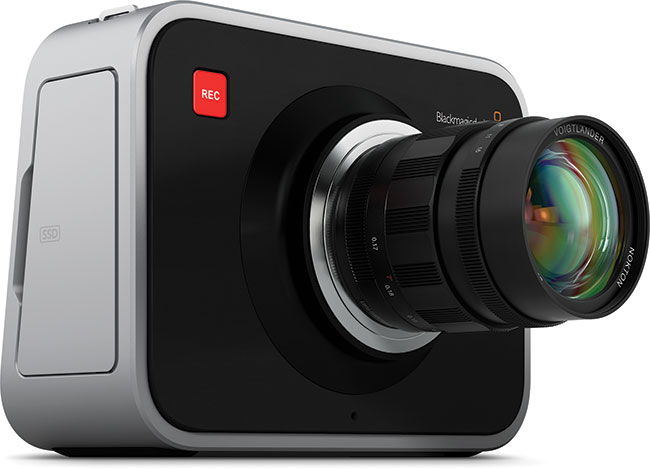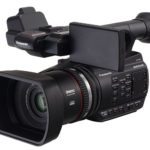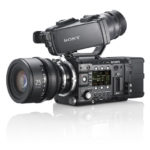
First Look Review: Blackmagic Design Cinema Camera
Posted on Nov 22, 2012 by Alex Fice
Blackmagic Design Cinema Camera with Sigma 8-16mm lens in BEBOB cage.
DEN LENNIE was lucky enough to use the Blackmagic Magic Cinema Camera as a Beta tester and found a product that re-writes what a low cost camera can offer.
When Blackmagic announced their Cinema Camera at NAB 2012 I don’t think anyone was expecting them to enter the cinema camera market with such a serious contender.
At first glance, there seemed to be a myriad of quirks that could easily put indie filmmakers off this camera. The key concerns seemed to be centered on the size of the sensor. The sensor is smaller than the Micro Four Thirds sensor and actually has what is the equivalent of a 2.3 crop factor when compared to full frame 35mm DSLRs.
Also the camera looked kind of weird. However all of these concerns were put to one side with the big show stopper that is the price point of this camera, a staggering £1995 plus VAT. That’s a camera capable of shooting 10-bit ProRes and 12-bit Cinema DNG Raw at 2.5K. In addition you get a full version of Resolve worth £655 along with a copy of Blackmagic’s UltraScope worth £455. So in effect you are getting the camera for £885.
So regardless of what you may have thought initially, it is going to be hard to ignore this entry into the camera market at this price point.
Fast forward to late August 2012 and I was asked if I would be one of the beta testers. Naturally this is a privilege and I gladly accepted the offer. I’m now fortunate to have a direct line to the camera design team and have already been offering suggestions for how I’d like to see the camera system evolve.
How did it Evolve?
John Brawley, a DP based in Sydney has been heavily involved in advising Blackmagic on how the picture should look for this camera. I had recorded a podcast with John and as a result of that podcast was feeling really confident about just how good the pictures were. John had been using the Blackmagic Cinema Camera alongside two Arri Alexa and a RED Epic on a Network Drama show he’d been shooting in Australia called Puberty Blues. (You can listen to that podcast at: http://www.fstopacademy.com/listen-2/black-magic-camera-john-brawley-interview/)
With a DP of John’s experience helping Blackmagic to refine the picture, I started to get quite excited. One of the questions I asked John was “isn’t the sensor size a problem?” to which he answered not one bit. It’s larger than Super 16 and slightly smaller than Super 35 and he said in reality the image size of the sensor and the crop factor had no real bearing on the work he was shooting.
Since shooting with this camera I’ve had the opportunity to try this out for myself and I have to agree. Also this crop size of the sensor (which is a slightly ambiguous term because it only relates to full frame DSLR and not cinematic standards), sits between Super 16mm and Super 35mm.
So here’s the deal with the size of the sensor. It is only really a factor when you are looking for a wide-angle shot. I’ve been using a Sigma 8mm to 16 mm lens which has given me the equivalent of 18 mm at the widest point which really is wide enough for most applications.
On the plus side, the camera’s crop factor means lenses such as the Canon L series 70 to 200mm IS or the Zeiss CP.2 70-200mm zoom actually becomes the equivalent field of view of 161mm to 460mm in equivalent focal length, at constant aperture of f2.8!
Format
Shooting in RAW mode records CinemaDNG files, so you get a 12-bit 2.5K raw file and 13 stops of dynamic range – this is staggering. (DNG files are actually individual still frames so you are also able to pull high res stills from any frame). You also have the option to shoot in 10-bit ProRes and DNxHD. I have been blown away by the quality of the image coming out of this camera since I began shooting back in August.
The thing that you notice straight away is the beautiful gradation of tone from shadow to highlight. One of the things that tends to let you down on an 8-bit camera format is the way in which highlights are rolled off as it hits clip. I’m not quite sure how Black Magic are doing this, (as I am not and never have been very technical), but the highlight roll off on this camera in both ProRes and RAW is simply beautiful. This gives the image a very film like quality.
What I have noticed is that pushing the exposure towards the highlight end seems to benefit this camera more than under exposing. Again very reminiscent of shooting on negative film.
Having the capability to shoot 2.5K RAW means that you have so much more data being acquired by the sensor and that means more options in post, especially when applying heavy grades or multiple effects and keys.
 Blackmagic Design Camera with Zeiss CP2 lens and Zacuto rig.
Blackmagic Design Camera with Zeiss CP2 lens and Zacuto rig.  Blackmagic Design Camera with BEBOB cage and Dovetail plate.
Blackmagic Design Camera with BEBOB cage and Dovetail plate.  Blackmagic Design Camera with Canon 16-35mm lens in BEBOB cage.
Blackmagic Design Camera with Canon 16-35mm lens in BEBOB cage.  Blackmagic Design Camera with Tokina 11-17 lens.
Blackmagic Design Camera with Tokina 11-17 lens.
So who is this camera aimed at?
The fact that Black Magic has made the BMCC (Black Magic Cinema Camera) with the form factor not dissimilar and in size to a DSLR with the Canon EF mount, you could argue that they’ve tried to pitch it directly at the DSLR user. However, the workflow required to convert CinemaDNG is a little bit more complex than editing DSLR footage, but it’s not difficult once you’ve learned how.
Using DaVinci Resolve 9 you can simply import your CinemaDNG files, adjust any exposure as necessary using the camera’s RAW controls and then export the working files, or dailies, into a format that suits your particular edit platform.
You then do your edit and round trip back to Resolve, relinking the ProRes proxy for example to your cinemaDNG. You can then grade your RAW files and once happy, export and render. You can then create a Resolve XML round trip back to Final Cut Pro X to do your finishing.
I’m new to Resolve and its workflow, which takes a little bit of getting used to. However, for the right projects, having this flexibility and ability to use all the bits that you’ve recorded is really powerful.
It is worth pointing out that I regard myself as a DP who is dabbling in colour grading.
I think it is very important as a DP to learn a little bit about colour grading. I don’t consider myself someone who’s going to take over the colourist role in any way shape or form, but it is great having the opportunity to ‘mess around’ in Resolve and to get a greater understanding of what can and cannot be achieved. I believe this helps me light more efficiently on location and not sweat situations where I know a fix during the grade might save spending 45 minutes re-lighting on set.
Shooting setup
The camera is being offered at a ridiculous price point, which is good for the user but please be aware you will need to invest in some other accessories and power solutions to really make this camera work at its optimum capacity. But lets not forget that Black Magic have named this a ‘Cinema Camera’. There’s a clue in the title.
Power
The camera has an internal battery and the way I view this battery is it’s a backup battery that will run for around 60 to 90 minutes. So adding a good power solution, offering you some additional power distribution, is a must for this camera. I’ve been using a fantastic power plate from Bebob which has four hi-Rose outputs and the option to access two D-Taps, (if you use their battery system), this gives plenty of power options to control the various accessories that I think you need to consider when using this camera.
Rig
Some kind of rig is going to be a must and there are several manufacturers now making rigs for this camera. I’ve been using rigs from Zacuto and Bebob. The Zacuto rig utilises some of the DSLR components I already own and the Bebob cage is a universal solution that is also very flexible especially when coupled with their lightweight dovetail. I’m also having a look at the rigs from Shape and am sure 3Ality Technica will be developing a Micron solution also. What rig works for you will be down to your own shooting style and preference. I think this camera has been designed to be a modular box that will need rigging, evident from the mounting points and form factor. Equally though you can strip back to the basics and hold the camera, using the big touch screen on the back if you needed to work in confined spaces, just as if you were shooting with a DSLR setup.
Monitoring
Whilst the touch screen on the rest of the BMCC is great I prefer some kind of electronic viewfinder that allows for flexibility in the position of and a viewing angle. I already own a Zacuto EVF and so by adding a SDI-HDMI convertor I can use that on this camera. I’ve also been using the Alphatron EVF which works well also.
Lenses And Mounts
Of course you need to consider lenses. The current model has a Canon mount and can accept Canon EF lenses and lenses such as the Zeiss CP.2 with their multiple mount options and are perfect companion for this camera. It is also worth noting that the Canon EF mount will transfer image stabilisation information and exposure information so when you’re using Canon EF lenses you can control both the image stabilisation and the aperture electronically via the camera controls.
At IBC, Blackmagic announced a Micro Four Thirds mount due for release at the end of this year. The Micro Four Thirds version will be a dumb mount therefore no image stabilisation information can be transferred. However the smaller flange depth of the Micro Four Thirds mount will allow for PL adapters and a variety of third-party adapters to work with the camera.
DSLR Shooters beware!
Just because this camera, has a similar form factor to DSLRs, that is where the similarity ends. If you’re planning to jump from DSLR straight to the Blackmagic Cinema Camera you need to be prepared for a bit of a learning curve, particularly when it comes to the workflow.
None of this is complex, it’s actually straightforward, especially when the creation of dailies can be done with the supplied free DaVinci Resolve software, but the RAW CinemaDNG files will take a bit of getting use to and so you need to make sure that your hardware is up to spec in order to make that workflow speedy. I’m using a 2012 3.4GHz i7 iMac with 12GB RAM that has a 2GB graphics card and connected to a Thunderbolt drive and it works well. I don’t get realtime playback but it’s workable
If you’re thinking about adopting the Blackmagic Cinema Camera and image quality is a priority to you then you will not be disappointed in the power and dynamic range of this camera. You do need to budget for some additional accessories to get going. Certainly an external EVF and a cage/rig of some description with an additional power solution would be the the minimum I’d recommend. However even factoring in these extras you are still looking at a far lower overall investment than other camera’s on the market that offer RAW.
So where does the Cinema Camera fit?
There has been a number of large sensor camcorders released since the DSLR revolution in 2009. Panasonic’s AF 101, Sony’s FS100, Sony’s FS700, and Canon’s C300, and C100. All worthy tools for different markets and budgets.
A few months back I shot a commercial in Spain with James Tonkin of Hangman Studios. This was a web only commercial featuring the footballer Ronaldo. For that shoot we chose a RED Scarlet. What I enjoyed about that shoot was just how simple the user interface was. I selected my ISO, selected my colour balance, chose the resolution I wanted to record at and off I went.
At that point I was really quite attracted to the RED Scarlet as a high-quality cinema production tool for the commercials music videos and a high-end production work that I do. Now I think the only camera’s that the BMCC will really hurt is the RED Scarlet and the DSLR market.
Granted the resolution of the BMCC only goes up to 2.5K and not 4K like the RED however in most cases for the kind of work that I’m doing 2.5K RAW is more than enough and I don’t think I can justify buying a RED at almost $20,000 per kit when I can achieve the same look and feel for my images spending £2000.
I still have a Sony FS100 and I intend on buying the Sony FS700 because each of these cameras still has a place. The FS700 offers 240 FPS at full 1080p, and with the 4K upgrade path on its way along with the Cine gammas on that camera, it is simply beautiful. If I want to work quickly recording to AVC HD I can, it grades well and the media is cheap and efficient.
However, what particularly excites me about the Blackmagic Cinema Camera is the bit depth and the images coming out of RAW, coupled with the option to shoot in ProRes. Working in ProRes allows you to shoot in a Log mode and takes an entire transcoding step out of my post production workflow. This simply means far more time can be spent on the creative process.
Hollywood’s dirty little secret is that in most cases productions shooting Arri’s Alexa are finding that shooting ProRes is good enough. If it is good enough for Hollywood, then it’s good enough for me!
These days you cannot just own one camera you need several and then it’s a case of the right camera for the job or shoot. The BMCC is a very impressive camera and at that price you can’t really afford not to want one.
 Blackmagic Design Camera with MFT lens mount and Voightlander lens.
Blackmagic Design Camera with MFT lens mount and Voightlander lens.
Den Lennie is a DP and one of the world’s leading coaches on the new wave of digital film making. He runs an online film school at fstopacademy.com and specialises in small group film making workshops all over the world.
Den has worked in the broadcast industry for over 20 years and in every major TV genre, including Music, Documentary, Travel, Sport, Factual and Entertainment. He has worked as a Lighting Cameraman, Director of Photography, Producer, Director and Editor.
He has first-hand experience of every part of the industry and how to create stand – out work. Den is a Sony Independent Certified Expert, A Tiffen Image Maker and in 2012 became the first official global ambassador for Carl Zeiss Lenses.
You can learn more about his experience with the BMCC at www.fstopacaemy.com/bmcc.








